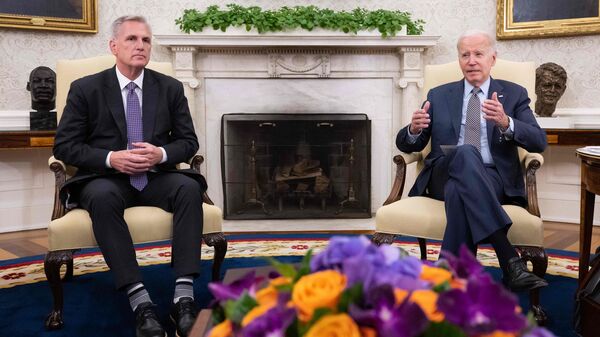On Sunday, US President Joe Biden and House Speaker Kevin McCarthy ended months of fevered speculation by agreeing to a deal that would raise the US debt ceiling. The deal, which must still pass a vote in Congress, helps the United States avert financial catastrophe. Mint breaks down the development.
- After months of tension and weeks of intense haggling, the Biden administration and US House of Representatives Speaker Kevin McCarthy hammered out a compromise that would allow the US to raise its debt ceiling.
- The debt ceiling, introduced during the First World War, dictates how much money the US government is allowed to borrow to pay off its debt and meet its social-security obligations, among other things. Raising the debt ceiling was once a routine political matter. It currently stands at a considerable $31.4 trillion.
- However, the debt ceiling has become an increasingly divisive issue in American politics in recent years as the Republican Party, which generally calls for restrained government spending and reducing the national debt, has demanded concessions in return for increasing the debt ceiling.
- This led to a pitched battle in 2011, when Republicans refused to raise the debt ceiling. The uncertainty caused by that bruising political battle, which ultimately ended in compromise, caused the US’s credit rating to be downgraded for the first time.
- The issue came up again in 2023 as America began to near its current debt ceiling. While President Biden called on Republicans to raise the ceiling and said he would not negotiate, Republicans demanded spending cuts in exchange for agreeing to raise the ceiling.
- As the political crisis dragged on, Treasury Secretary Janet Yellen said the country was close to running out of funds. Without the ability to borrow more, America would be unable to pay its debts, not to mention various government services.
- The US defaulting on its debt would have had catastrophic consequences for the global economy because of the central role of the US dollar and the importance of the US Treasury bonds in the global financial system.
- Eventually, Democrats and Republicans forged a compromise, suspending the debt limit until January 2025. Meanwhile, government spending will stay flat next year with the exception of defence spending, which will be allowed a modest increase. In 2025, increases in spending will be capped at 1%.
- Biden was largely able to shield social-security programs from cuts, including his signature student-debt-relief and climate-change bills. However, Republicans were able to ensure there will be no new tax hikes on wealthier citizens and that those on food stamps will have strict work requirements.
- As President Biden put it, both sides didn’t get exactly what they wanted. While the Democrats initially insisted that they would not negotiate with Republicans, they eventually came to the table. But the Republicans were unable to secure deep spending freezes they had hoped for. The deal will now go to a vote in America’s Congress.
Catch all the Business News, Market News, Breaking News Events and Latest News Updates on Live Mint.
Download The Mint News App to get Daily Market Updates.
Download The Mint News App to get Daily Market Updates.
More
Less
Updated: 30 May 2023, 03:28 PM IST
#Mint #Explainer #Americas #debtceiling #compromise
